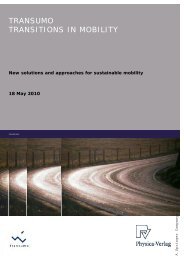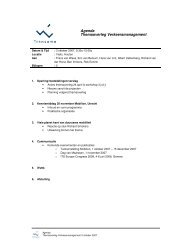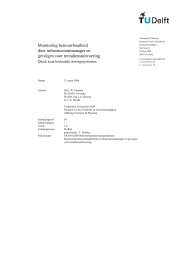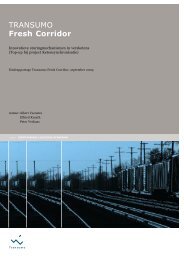Casestudie Breakdown prediction Contell PILOT - Transumo
Casestudie Breakdown prediction Contell PILOT - Transumo
Casestudie Breakdown prediction Contell PILOT - Transumo
You also want an ePaper? Increase the reach of your titles
YUMPU automatically turns print PDFs into web optimized ePapers that Google loves.
As all these software products fail to offer a satisfying solution, Matlab is used in the<br />
following to implement the suggested methods. In fact, also Matlab has some<br />
problems to import the original datasets, but these problems can easily be solved by<br />
changing some delimiters in the CSV file. 75 Moreover, Matlab is capable of importing<br />
date and time correctly and is able to process very large datasets.<br />
In the following, the general ideas of the made implementation will be introduced.<br />
The technical realization and annotations to occurred problems, due to Matlab’s<br />
limited programming possibilities, can be found in the appendix.<br />
Caused by the storage behavior of XiltriX 76 the stored values contain different time<br />
intervals. An example of this behavior is pictured in Figure 6-1. But the suggested<br />
analyzing methods from section 5.10 assume constant time ranges. Hence, the first<br />
step of data analysis is an interpolation of the stored datasets.<br />
The basic idea is, to create new datasets of measurement values that contain regular<br />
time intervals. Door openings are stored to the beginning of the minute, in which they<br />
occur. A combination of the original and the interpolated datasets can be used to<br />
calculate the desired values, as described in the following, without making<br />
adaptations to the described methods. Certainly, in case of an implementation to<br />
XiltriX, its storage behavior should be adapted, so that interpolation is not necessary<br />
any more.<br />
After this interpolation, the desired statistical measures can be calculated. Therefore,<br />
the original and the interpolated datasets are divided into single days and these days<br />
again into daytime and nighttime. As described in section 5.10.1, daytime limits can<br />
be obtained by analyzing the door openings. Based on these made classes, the<br />
promising measures maximum, minimum, mean, standard deviation and the number<br />
of door openings can be calculated on the aimed basis of daytime, nighttime and<br />
whole day.<br />
To obtain correct results, the calculation of minimum and maximum values has to be<br />
based on the original data to avoid smoothing. By contrast, mean as well as standard<br />
deviation has to be based on the interpolated data to achieve a correct weighting in<br />
time. The determination of door openings can be based on both datasets, because<br />
the number of door openings remains unchanged after interpolation. The also aimed<br />
goal, to plot a temperature distribution, can be implemented easily by just counting<br />
75 See appendix for details<br />
76 See section 3.2.1 for details<br />
87
















